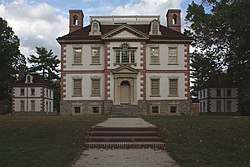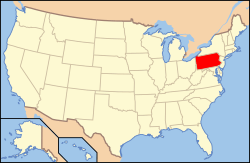Mount Pleasant (mansion)
Mount Pleasant is a historic mansion in Philadelphia, Pennsylvania, atop cliffs overlooking the Schuylkill River. It was built about 1761–62 in what was then the countryside outside the city by John Macpherson and his wife Margaret. Macpherson was a privateer, or perhaps a pirate, who had had "an arm twice shot off" according to John Adams. He named the house "Clunie" after the ancient seat of his family's clan in Scotland.[3]
Mount Pleasant | |
 River facade | |
   | |
| Location | Mount Pleasant Drive, between Kelly Drive and Columbia Avenue Fairmount Park Philadelphia, Pennsylvania, United States |
|---|---|
| Coordinates | 39°59′0″N 75°11′59″W |
| Area | < 1-acre (4,000 m2) |
| Built | c.1761 |
| Architectural style | Georgian |
| NRHP reference No. | 66000685 |
| Significant dates | |
| Added to NRHP | October 15, 1966[1] |
| Designated NHL | May 30, 1974[2] |
The builder-architect was Thomas Nevell (1721–1797), an apprentice of Edmund Woolley, who built Independence Hall. The house is administered by the Philadelphia Museum of Art in Fairmount Park.[4]
It was declared a National Historic Landmark in 1974.[2][5]
Architecture and history
The Georgian mansion has an entrance topped by a pediment supported by Doric columns.[6] A balustrade crowns the roof which also has prominent dormers and two large chimneys. Two small symmetrical pavilions flank the main house, an office and a summer kitchen. All are adorned with brick quoins.
John Adams visited the mansion in 1775 and called it "the most elegant seat in Pennsylvania." The interiors contain the original paneling with ornamental carving, and still show the "elegance of the lifestyle of colonial elites," as well as souvenirs of Macpherson's life and times and period furniture by craftsmen such as Martin Jugiez. The furniture is from the collections of the Philadelphia Museum of Art.[7]
Mount Pleasant was also home to Benedict Arnold and his wife Peggy Shippen. Arnold purchased the mansion on March 22, 1779 for his new bride, and specifically made the property over to her, although, due to the high price of the estate and Benedicts deteriorating funds, he had to sell it, thus the couple never got a chance to move in.
In 1792, the mansion was purchased by Jonathan Williams, first superintendent of West Point and grandnephew of Benjamin Franklin. He lived there intermittently until his death in 1815, and his children sold the estate to Fairmount Park.
The structure was restored in 1926 by the Philadelphia Museum of Art.
Gallery
_by_anonymous_(circa_1772-1792).jpg) Captain John Macpherson (1726–1792)
Captain John Macpherson (1726–1792) Historic American Buildings Survey, aerial view, looking west, 2003
Historic American Buildings Survey, aerial view, looking west, 2003_(14765158364).jpg) Patlor, 1948
Patlor, 1948 Historic American Buildings Survey, main hall and stairway, 1960
Historic American Buildings Survey, main hall and stairway, 1960 Historic American Buildings Survey, second floor hallway, 1960
Historic American Buildings Survey, second floor hallway, 1960
See also
References
Notes
- "National Register Information System". National Register of Historic Places. National Park Service. January 23, 2007.
- "Mount Pleasant". National Historic Landmark summary listing. National Park Service. Archived from the original on June 6, 2011. Retrieved March 15, 2008.
- "Mount Pleasant". Independence Hall Association.
- "Fairmount Park Houses: Mount Pleasant". Philadelphia Museum of Art.
- Patricia Heintzelman (August 30, 1974). "National Register of Historic Places Inventory-Nomination:" (pdf). National Park Service. Cite journal requires
|journal=(help) and Accompanying seven photos, exterior and interior, from 1974 and undated (32 KB) - Mount Pleasant :: gophila.com – The Official Visitor Site for Greater Philadelphia
- Mount Pleasant, Philadelphia Museum of Art. Accessed May 22, 2012.
External links
| Wikimedia Commons has media related to Mount Pleasant mansion. |
- Philadelphia Museum of Art: Fairmount Park Houses – visiting information
- Philadelphia Museum of Art: Saving a Colonial Masterpiece: Mount Pleasant Restored
- Historic American Buildings Survey, including 44 photographs and 32 measured drawings
- Description of Mount Pleasant at the Historical Society of Philadelphia

